Traimak_Ivan/iStock via Getty Images
Fortive’s Prospects And Challenges
Fortive Corporation (NYSE:FTV) provides intelligent engineered products, software, and services. It also sells health, safety, and quality enterprise software products for various industries, including manufacturing, healthcare, utilities, communications, and electronics. The most significant change in the company’s business model has come from a shift to relying on recurring revenue and diversification. For the rest of 2022, its operating segments will likely improve revenue and profit margins. Globalizing its brands across various geographic regions will also help accelerate growth.
However, the economic impact of the current recession, the supply chain issues, the China lockdown, and the adverse movement of foreign exchanges against the US dollar would take their toll on the cash flows. So, free cash flows declined in 1H 2022. The stock is relatively overvalued compared to its peers. Fortunately, it has low leverage and robust liquidity, which can expand its relative valuation multiples when the economy struggles. Nonetheless, I think the stock is still apt to hold for investors looking at the long-term return horizon.
Strategies: A Critical Look
Over the past few years, FTV has transformed its business portfolio, emphasized a diversified end market, and generated durable recurring revenue. The company has added software and consumables business while expanding its service business model. Earlier, retail fueling and vehicle repair markets contributed heavily to its total revenue mix. Now, healthcare has become the primary driver. The advantage of the new model is that the revenue is recurring. Plus, it caters to varied end markets.
Tektronix is a case at this point. In Q2, the company saw mid-20% bookings growth at Tektronix (which provides test and measurement instruments in various industries), mid-teens growth in sensing technologies, and 20%-plus growth in Gems (Gems Sensor, a subsidiary). The company also leverages its brand value by commercializing and globalizing its brands across various geographic regions. So, the recurring revenue share doubled from 2016 to 2022.
Q3 and FY2022 Forecast
In Q3 and Q4, the management expects revenues to increase by “single digit to low double digits,” while the adjusted operating profit margins can grow by 100 basis points year-over-year. Adjusted earnings per share can increase by 12%-16% from Q2 to Q3 and by a further 8%-11% in Q4.
Each of its three operating segments will likely see topline rising. The company’s revenues in FY2022 can increase by 8% to 9.5%. Better operational performance and lower taxes can produce $3.07-$3.13 in adjusted earnings per share in FY2022. So, improved performance can offset an expected $100 million charge due to adverse foreign exchange movement ($0.08 per share).
Over the next three years, the company plans to achieve a “mid-single-digit” core revenue growth. It also looks to expand its operating margin by 300 basis points or a 50% growth in earnings. The profit growth can also reflect in 90% growth in free cash flow.
The Outlook And Current Drivers
By Q2-end, its hardware backlog was 21% higher than the beginning of the year. I expect its core business to grow for the remainder of 2022 due to a resilient product portfolio and continued customer demand. New logo generation, cross-sell bookings, and lower customer churn should keep its software sales high in 2022.
In 2022, hardware orders and software revenues increased, albeit moderately, following the company’s transition to a diversified product portfolio. Despite higher inflation and the loss from foreign exchange movements, its gross profit margin remained unchanged from Q1 to Q2, while the EBITDA margin expanded by 140 basis points.
In Q2, on a geographic basis, the Western Europe regions proliferated (revenues up by “mid-teens”), while North America revenues were up by “high single digits.” China saw ~20% order growth, despite the Shanghai lockdowns.
Analyzing The Segment Performance
In the Intelligent Operating Solutions segment, revenues increased by 16% in Q2 year-over-year. Sharp improvements in shipments and robust price realization led to a 205-basis point operating margin expansion in Q2 in this segment.
In Precision Technologies, revenues increased by 6% in Q2 2022 compared to Q2 2021. The industrial, semi, medical, power, and energy markets witnessed steady growth. Higher usage of power and precision devices and expanded use of semiconductors led to the topline growth in this segment. Backlogs also went up during Q2. The superior operating performance of Tektronix and Sensing Technologies overcame the hurdles of Shanghai lockdowns. Favorable pricing and cost management also resulted in 90 basis point adjusted profit margin expansion.
In Advanced Healthcare Solutions, revenue growth in Western Europe exceeded the revenue growth in North America in Q2. Higher ASP (Advanced Sterilization Products business) consumables increased sales in North America in Q2. However, disruptions from COVID presented challenges owing to staffing issues, and capital equipment constraints muddled the growth rate in Q2. Investors may note that FTV acquired ASP in April 2019 for $2.7 billion. Following the Provation acquisition, the company has invested in FBS (Fortive Business System) tools, which drove productivity savings and improved adjusted operating margin by 300 basis points in Q2 over a year ago.
Steady Dividend
FTV pays an annual dividend of $0.28 per share, translating into a 0.43% dividend yield. The dividend rate has changed little over the past five years. Dover Corporation’s (DOV) forward dividend yield is 1.56%, while Snap-on Incorporated’s (SNA) dividend yield is higher (2.54%).
Strong Balance Sheet
In 1H 2022, FTV’s cash flow from operations (or CFO) increased by 20% compared to a year ago, led by higher year-over-year revenues. Capex, excluding the acquisition part, raised sharply in 1H 2022, leading to a modest 16% higher free cash flow (or FCF) in the past year.
FTV’s liquidity (cash plus commercial paper) totaled $3.0 billion as of June 30. Its debt-to-equity ratio (0.39x) is lower than its competitors (DOV, OTCPK:TTNDY, and IR) average of 0.64x. The management considers M&A to be the principal driver of capital deployment. Year-to-date, it has repurchased 4 million shares. Acquisitions and share repurchases have provided reasonable returns to its shareholders.
Analyst Rating And Relative Valuation
According to Seeking Alpha, 14 sell-side analysts rated FTV a “buy” in the past 90 days (including “strong buy”), while six recommended a “hold.” None of the analysts rated it a “sell.” The Wall Street analysts’ estimates suggest a 17% upside at the current price.
FTV’s forward EV/EBITDA multiple compression versus the current EV/EBITDA is less steep than its peers. This implies the company’s EBITDA can increase less sharply than its peers in the next four quarters. This would typically result in a lower EV/EBITDA multiple than its peers. The stock’s EV/EBITDA multiple (18.5x) is higher than its peers’ (DOV, TTNDY, and IR) average of 15.6x. So, the stock is relatively overvalued versus its peers.
What’s The Take On FTV?
Fortive Corporation’s focus on the healthcare business away from the legacy retail fueling and vehicle repair markets over the past few years has led to a stable operating margin. Its investments in Fortive Business System tools drove productivity savings and improved adjusted operating margins. I expect its core business to grow for the remainder of 2022 due to a resilient product portfolio and continued customer demand.
In 2H 2022, its net earnings may take a $100 million hit from foreign exchange headwinds. Plus, the Chinese lockdown and slow economic activities in the US and some other regions can lower its free cash flows. However, low leverage and robust liquidity can put off any imminent risk. The stock performed in line with the SPDR S&P 500 Trust ETF (SPY) in the past year. Acquisitions and share repurchases have provided reasonable returns to its shareholders. Given the valuation stretch, I think the investors might want to hold the stock now and may invest at a lower price for long-term returns.


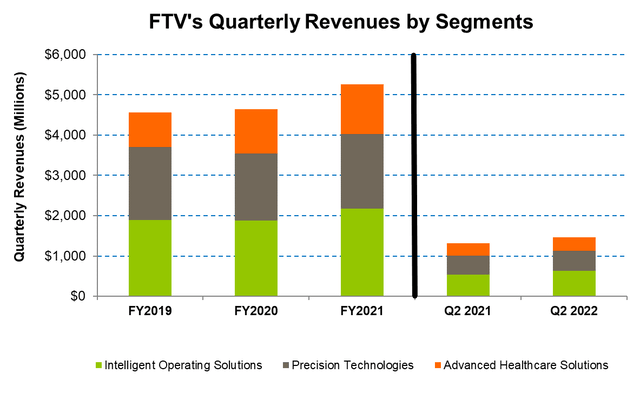
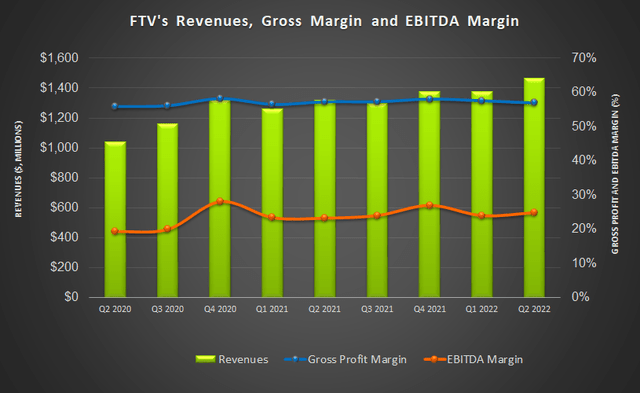
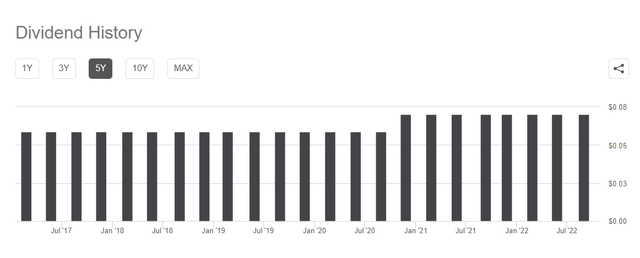
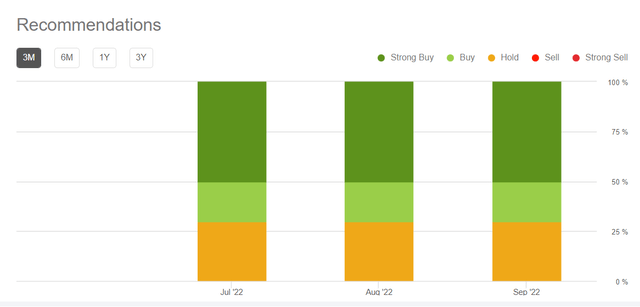
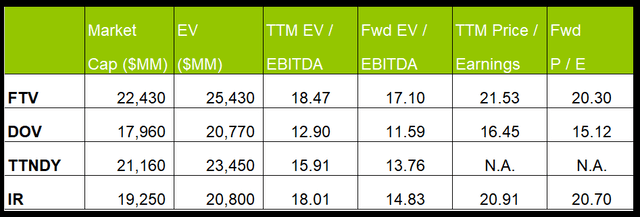
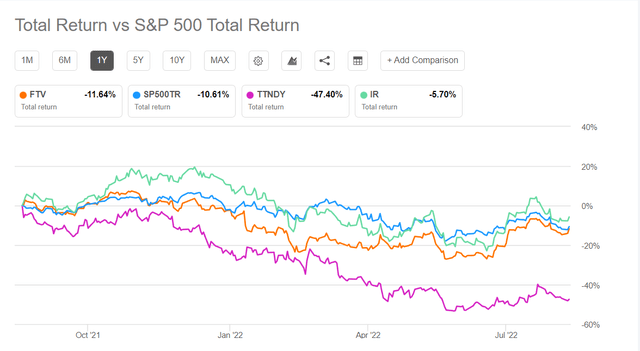
Be the first to comment